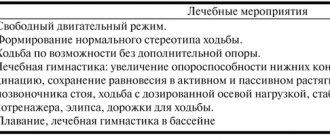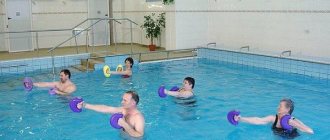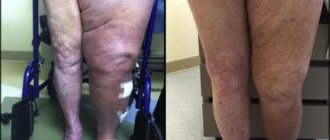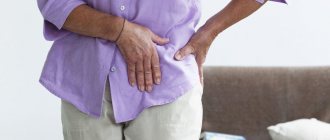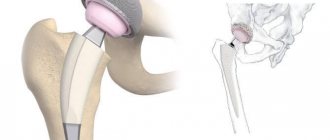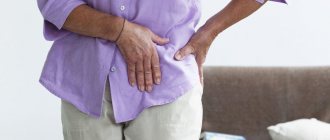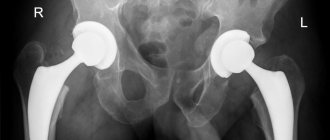After lower limb joint replacement, you must use crutches or a special walker to move around. Walking with support devices is an important part of the rehabilitation process. With its help, patients maintain good physical shape during the postoperative period and quickly return to their usual lifestyle.
When choosing crutches, it is better to choose subulnar crutches over axillary crutches. With their help, it is easier to move in confined spaces, they are lighter and more maneuverable.
How to go up and down stairs
When going up the stairs, grab the railing with your free hand, place your healthy leg on the step above, then place your cane on the step, and leaning on the cane, step up with your bad leg. In this case, the leg and cane should be on the same line. When descending the stairs, you need to proceed in the reverse order: first put both feet together and place the cane on the step below, then step with the injured leg, leaning slightly forward and holding the handrail with your free hand. After this, place your healthy leg on the same step. In order not to make mistakes when descending or ascending, you can remember the simple phrase “Up with the healthy leg, down with the sick leg.”
Cane selection:
It is necessary to determine what degree of stability a person needs, because...
they have one support, three support and four support. Many people wear shoes with different platforms, so it is recommended to choose a telescopic cane that can be adjusted according to height. Canes should be used both in summer and in winter. Therefore, it is recommended to choose canes with an anti-slip device (anti-slip device). In almost all models, the UPS can be extended or retracted as needed. Or use specialized attachments for winter. To choose the right cane length, you need to stand straight, lower your arms freely and bend them slightly at the elbow (about 15-20 degrees) - while the handle of the cane should be at the level of the bend line of the wrist.
When selecting a cane, the patient should be in familiar shoes; and if he plans to wear shoes with heels of different lengths, then it is better to purchase a cane that is adjustable in height. If the cane is too long, the load on the shoulder joint increases and the body is constantly in a skewed position. If the cane is too short, the patient will constantly slouch and lean forward, which increases pressure on the nerves in the wrist.
of a cane can vary on average from 100 to 400 grams, and it is very important that when selecting a cane the patient determines what weight is optimal for him. If the cane is too light, it can make you feel unsteady and unreliable. If the cane is too heavy, the supporting arm will get tired faster.
If the cane is planned to be used daily, then the shape of the handle is important, since in this case the cane will be in constant contact with the person’s palm, and it is important that this contact is as comfortable as possible. Due to the awkward shape of the handle, a person will experience pain in the palm and wrist area day after day. The ideal handle is one that follows the contours of the palm (anatomically shaped handle). A handle with a larger diameter is always easier to hold, but everything is individual, and when choosing the shape of the handle you need to rely, first of all, on your own feelings.
Rules for walking with a cane:
According to the recommendations of traumatologists, the cane should be worn in the hand opposite the injured or weakened leg - only in this case the load is distributed correctly. That is, if your left leg is injured, then the cane should be held in your right hand. Before you go out with a cane, you need to practice walking with it at home in the presence of someone else.
First you need to make sure that the cane is in the right hand. Then, leaning on the healthy leg, step forward with the cane and the bad leg at the same time, and only after that, leaning on the cane, step with the healthy leg. When walking with a cane, you should transfer your body weight as much as possible, thereby easing the load on the injured limb.
While walking up the stairs, grab the railing with your free hand, place your healthy leg on the step above, then place your cane on the step, and leaning on the cane, step up with your bad leg. In this case, the leg and cane should be on the same line. When descending the stairs, you need to proceed in the reverse order: first put both feet together and place the cane on the step below, then step with the injured leg, leaning slightly forward and holding the handrail with your free hand. After this, place your healthy leg on the same step. In order not to make mistakes when descending or ascending, you can remember the simple phrase “Up with the healthy leg, down with the sick leg.”
In order for the cane to serve as a truly reliable support, it must be equipped with a tip. The tips are made of plastic or soft rubber. Before you start using the cane, you need to make sure that the tip fits tightly to the shaft and does not slip off while walking.
To make the reed last longer, you need to keep it clean and regularly wipe it, first with a damp and then with a dry cloth. All plastic parts can be cleaned using special plastic cleaning fluids. Do not use solvents or oily liquids as cleaners. The reed should be checked regularly for cracks and tip wear. Don't wait until the tip wears off completely - it's better to replace it at the first sign of damage or wear.
Safety precautions:
- Before you go outside with your cane, check the shaft and tip for damage. Do not use a defective cane.
- If the cane is telescopic, make sure that the locking lock is securely latched.
- When going up or down stairs, always hold the handrail with your free hand.
- When walking, keep the cane as vertical as possible.
- Don't place the cane too far away from you.
- Use the cane only for its intended purpose.
- Do not hang bags, packages, etc. on the cane.
- Do not leave the reed in direct sunlight for long periods of time.
- In winter, do not go outside with a cane that is not equipped with an anti-slip device (ASD).
- Walk very carefully on tiles and loose carpets and rugs.
- If you fall, try to swing the cane to the side to avoid falling on it.
12/MR.H Cane for support when walking
A high-quality, lightweight support cane MIKIRAD 12/MR.H with a soft curved handle in hygroscopic and hypoallergenic polyurethane foam, manufactured in Poland according to European standards. It has telescopic height adjustment, eight positions in 2 cm increments. The product undergoes special processing! Not afraid of moisture and reagents! Maximum load 120 kg.
12/MR.L Cane for support when walking
The high-quality support cane MIKIRAD 12/MR.L with a curved “swan” handle, which, due to its “special” shape, compensates for the shock load when walking, is equipped with a strap for fixing on the wrist. Made in Poland according to European standards. The product undergoes special processing. Not afraid of moisture and reagents.
14/MR Folding cane for support when walking
folding support cane unfolds automatically under the influence of its own weight - with a “wave” of the hand, with an ergonomic handle for either hand, which can be stored in a bag-cover. It will always be at hand at the right time. Takes up little space and has a carrying case. Equipped with a reflective element. Rod material: thin-walled aluminum pipes.
16/MR.L Cane four-legged
of the support legs is designed so as not to interfere with people when moving. The cane has height adjustment for support under the arm. The rehabilitation device is equipped with reflective elements. Rod diameter above the tip: 20 mm, below the handle: 22 mm. Rod material: thin-walled aluminum pipes.
15/MR.L Three-legged cane
of the support legs is designed so as not to interfere with people when moving. The cane has height adjustment for support under the arm. The rehabilitation device is equipped with reflective elements. Rod material: thin-walled aluminum pipes.
FS 929L Aluminum cane with UPS
The cant can be used to move around at home or on the street. The cane is made of lightweight, durable and corrosion-resistant aluminum alloy. It has an enamel paint coating. The T-shaped handle is made of durable non-slip plastic.
11/MR/L Cane with anatomical handle for support when walking
High -quality support cane MIKIRAD 11/MR.L with an anatomical handle, manufactured in Poland according to European standards. Adjustable in height. Telescopic height adjustment, eight positions in 2 cm increments. Anatomical handle for the left hand!
12/MR Cane for support when walking
High -quality and lightweight support cane MIKIRAD 12/MR with a universal handle, manufactured in Poland according to European standards. Adjustable in height.
16/MR.KL04 Four-legged crutch
of the support legs is designed so as not to interfere with people when moving. The crutch has a height adjustment for support under the arm. The rehabilitation device is equipped with reflective elements.
15/MR.Kr Three-legged crutch
The cooler has two adjustments. One adjusts the height for support under the arm, the second adjusts the height of the armpit support. The design of the support legs is designed so as not to interfere with people when moving. The rehabilitation device is equipped with reflective elements.
13/MR.P Nozzle
It has a universal attachment with increased stability, with the ability to rotate 360° in place without lifting the cane from the surface. Concentric tread for effective traction.
13/MR.Z Nozzle
The threaded pins are screwed into a plastic ring, which is sealed in a rubber base. This allows the product to be both durable and elastic! Spikes prevent snow from accumulating!
FS 913 L Folding walker “Armed”
shoes are made of aluminum and have rubber and plastic handles. The walker can be folded and is very convenient for storage. The legs are equipped with anti-slip rubber tips. Soft lining for handrails.
FS 912 L Folding walker on wheels “Armed”
Lightweight aluminum alloy walkers with wheels can be used as an adjustable support for independent movement of people with various disorders of the musculoskeletal system. In addition, this is an excellent option for walking for people who have suffered a heart attack, stroke or surgery, especially during the period of their rehabilitation.
these and many other products at ORTO orthopedic salons https://www.orto163.ru
Tip
In order for the cane to serve as a truly reliable support, it must be equipped with a tip. The tips are made of plastic or soft rubber with a small metal plate inside that protects the tip from being pierced by the shaft pipe. Tips are available with a diameter of 2.5 to 5 cm and are selected depending on the thickness of the cane - before you start using the cane, you need to make sure that the tip fits tightly to the shaft and will not slip off while walking. During the cold season, you should not neglect various anti-slip devices.
Cane care
To make the reed last longer, you need to keep it clean and regularly wipe it with a damp and then a dry cloth. All plastic parts can be cleaned using special plastic cleaning fluids. Do not use solvents or oily liquids as cleaners. The reed should be checked regularly for cracks and tip wear. Don't wait until the tip wears off completely - it's better to replace it at the first sign of damage or wear.
Safety precautions
To stay safe while walking with a cane, you should take certain precautions.
- Before you go outside with your cane, check the shaft and tip for damage. Do not use a defective cane.
- If the cane is telescopic, make sure that the locking lock is securely latched.
- When purchasing a cane, check what load it can withstand. The maximum permissible load on the cane should not be less than your weight.
- When going up or down stairs, always hold the handrail with your free hand.
- When walking, keep the cane as vertical as possible.
- Don't place the cane too far away from you.
- Use the cane only for its intended purpose.
- Do not hang bags, packages, etc. on the cane.
- Do not leave the reed in direct sunlight for long periods of time.
- In winter, do not go outside with a cane that is not equipped with an anti-slip device.
- Walk very carefully on tiles and loose carpets and rugs.
- If you fall, try to swing the cane to the side to avoid falling on it.
Purposes of using crutches after endoprosthetics
Replacing a joint with an artificial one is a complex process. During surgery, not only bones, but also soft tissues are damaged. The functions of the lower extremities do not recover on their own after surgery, unlike the anatomical integrity of the joint. To resume independent movement after hip replacement, it is necessary to walk on crutches.
The main reasons to use walking aids are:
- Fall protection. Weakness and dizziness are common in the first days after surgery. When actively moving, you can lean on crutches to rest. With their help, you can walk as much as you like and not be afraid of falling.
- Reducing the load on the operated leg. Partial weight bearing prevents injury and allows the postoperative wound to heal faster. Since the implants are not overloaded, motor functions are restored faster.
- To use crutches, the muscles of the torso, shoulder girdle and arms must be well developed. For older and physically weak people, walkers are better suited.
